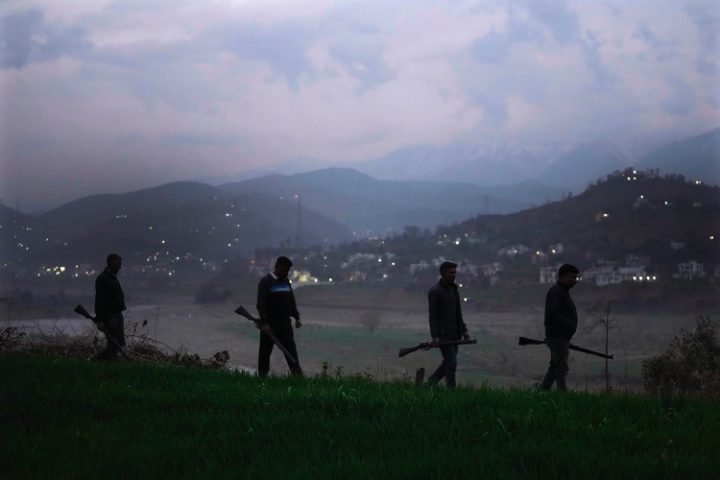
Following the killing of seven Hindus back in January amid two attacks in Dhangri village in India’s Kashmir region, the country’s authorities have brought back a government-funded militia — providing thousands of villagers, including some teenagers, arms and training.
Officially known as the “Village Defense Group,” the militia was first founded in the 1990s to provide a first line of defense against anti-Indian fighters in isolated Himalayan villages where the government had difficulty sending aid rapidly.
But the militia was initially disbanded due to reports of brutality by some of its members, which elicited criticism from human-rights organizations.
The revival of the militia came after residents of the areas affected by the violence took to the streets by the hundreds in furious protests.
The January violence in the frontier Rajouri district, which lies near the militarized border dividing Indian Kashmir from Pakistan, awoke bitter memories of the past.
It began on January 1, when four villagers were killed by two gunmen, and five others were wounded. The very next day, an explosion killed two children and injured at least 10 other people — one of whom eventually died of his wounds in the hospital.
Police said those responsible were militants who oppose Indian rule, although authorities have not yet named any suspects.
Both Indian and Pakistan claim Kashmir, which is 68-percent Muslim. Of Dhangri villages’ approximately 5,000 population, however, Hindus are the majority at 70 percent.
Kashmir formerly enjoyed a degree of autonomy, but the Indian government took direct control of the region in 2019, provoking high tensions as Muslim Kashmiris feel that the government is trying to stamp out their identity and religion.
The Associated Press notes of the revitalized militia:
Officials said they have since armed and provided weapons training to over 100 other Hindu men in Dhangri, while also lifting the ban on gun licenses in the already militarized Rajouri. The village already had over 70 former militiamen, some of whom still possess the colonial British-era Lee–Enfield rifles allotted to them over a decade ago.
For the first time, the militia has also been financially incentivized by the government, which said each member would be paid 4,000 Indian rupees ($48) a month.
… India has a long history of arming civilians in its counterinsurgency efforts and civilian militiamen were first used to fight separatists in India’s northeastern states. In 2005, India’s federal government founded a local militia, the Salwa Judum, to combat Maoist rebels in the central Chhattisgarh state. It was accused by rights groups of committing widespread atrocities and was disbanded in 2011.
The move is not without its critics, some of whom fear the policy could worsen divisions in areas already known for high levels of religious strife.
“Small arms proliferation is dangerous for any society and when a state does it, it’s a tacit admission of failure to secure a society,” political analyst Zafar Choudhary told AP.
Per government data, militiamen in the Jammu region have in the past been the subjects of more than 200 police cases, including incidents of rioting, murder, and rape.
For Choudhary, “civilians are not armed in a functional democracy.”
Security officials, however, maintain that the militias have been helpful in the past. They argue that the arming of civilians served as a deterrent to military activity and prevented Hindus from being forced out of remote areas — the fate that befell many Hindus in the Kashmir valley, who fled their homes amid threats and the killing of local leaders by Muslims.
“It was an experiment but it worked,” said Kuldeep Khoda, a top police officer in the region who was involved in the original militia program.
The region’s police even received an award from the U.S.-based International Association of Chiefs of Police for its work building up the civil defense force.
For Khoda, arming the people “played a pivotal role in defeating Pakistani designs to instigate communal tensions.”
Some observers are criticizing the practice of the new defense force refusing Muslims who want to join.
Former Indian Army soldier Satish Kumar called the decision not to arm Muslims “arbitrary,” as “we still do not know who carried out the massacre.”
One resident of neighboring village Kalal Khas, 38-year-old Usha Raina, has been a militia member since 2015. She told AP that “We had locked up our guns and thought we would never need them.”
“The incident [in Dhangri] has scared us all and the guns are back in our living rooms,” Raina added.
The latest out of Kashmir serves as a prime example of the importance of the right to keep and bear arms, which the U.S. Constitution protects, but which is not legally enshrined in many parts of the world.
Although many anti-gun intellectuals may scoff at the notion of arming civilians, the situation in Dhangri village shows that even in the modern world, there are situations in which people cannot depend on police or other government authorities to protect them.




